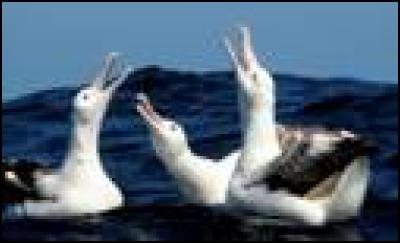Seabird report highlights NZ’s global responsibility
Seabird report highlights NZ’s global
responsibility

Photo credit:
David Hallett.
A new report has identified significant areas of New Zealand’s land and sea that require special consideration to protect the seabirds that depend on these places for their survival. Forest & Bird says it has major implications for the government’s ongoing large-scale sell-off of deep sea oil and gas drilling rights.
The report, New Zealand Seabirds: Important Bird Areas and Conservation will be launched today by independent conservation organisation Forest & Bird. The report is part of a global effort to identify where bird species live to ensure threatened species are adequately protected.
“New Zealand has
an extraordinary wealth of seabirds,” says Forest & Bird
Seabird Advocate Karen Baird. “More than one-third of the
world’s seabird species live at least part of their lives
in our Exclusive Economic Zone.
“New Zealand also has
more seabird species that breed only within its jurisdiction
than any other country in the world. We have 36 species.
Mexico is next on the list, with only five species.
“Sadly, New Zealand also has more threatened seabird species than anywhere else in the world. These include the Chatham Island taiko, yellow-eyed penguin, Antipodean wandering albatross, the New Zealand fairy tern – with only 10 pairs left - and the tiny New Zealand storm petrel; which was recently discovered breeding on Little Barrier Island in the Hauraki Gulf, and which was thought to be extinct until 2003,” Karen Baird says.
Because many seabird species spend their lives at sea, it is very hard to work out which areas are important for them to breed or forage. The global Important Bird Areas (IBAs) project uses agreed scientific criteria from Forest & Bird’s partner, BirdLife International, to begin the process of identifying where internationally-recognised marine IBAs are.
Because New Zealand is home to so many seabird species, there are many IBAs that have been identified across the country, and in New Zealand’s waters (see map, attached). There are 69 within our territorial seas and Exclusive Economic Zone alone.
“The sheer number of IBAs for seabirds calls for a major rethink of the mass sell-off of deep water oil and gas drilling rights within our EEZ. As the industry oil spill modelling shows, a deep sea blowout could cover thousands of square kilometres of bird habitat in oil – which in turn could push some species to the brink of extinction,” Karen Baird says. “All threats to all IBAs for seabirds will need to be minimised, including those from fishing and uncontrolled coastal development.
“The report will also be valuable for local communities and agencies to help them protect the significant populations of threatened seabirds that spend at least part of the year in their neighbourhoods,” Karen Baird says.
The attachment includes a map showing where IBAs can be found on and around New Zealand.
The report can be downloaded from here.
ends


 Gordon Campbell: On What’s Wrong With The Treaty Principles Bill
Gordon Campbell: On What’s Wrong With The Treaty Principles Bill Ministry For Culture And Heritage: Reverberations Of Erebus Disaster Still Felt 45 Years Later
Ministry For Culture And Heritage: Reverberations Of Erebus Disaster Still Felt 45 Years Later Watercare Services: No Cause For Concern After Slightly Elevated Levels Of Arsenic Detected In Treated Waikato River Water
Watercare Services: No Cause For Concern After Slightly Elevated Levels Of Arsenic Detected In Treated Waikato River Water Te Pāti Māori: Government’s First Year A ‘Catastrophe For Māori’
Te Pāti Māori: Government’s First Year A ‘Catastrophe For Māori’ Department Of Internal Affairs: Samoan Citizenship Bill Passes Into Law
Department Of Internal Affairs: Samoan Citizenship Bill Passes Into Law NZ National Party: National Acknowledges The Passing Of Hon Nikki Kaye
NZ National Party: National Acknowledges The Passing Of Hon Nikki Kaye Mana Mokopuna: Children And Young People Share Vital Insights On Healing From Family Violence And Sexual Violence In New Report
Mana Mokopuna: Children And Young People Share Vital Insights On Healing From Family Violence And Sexual Violence In New Report


